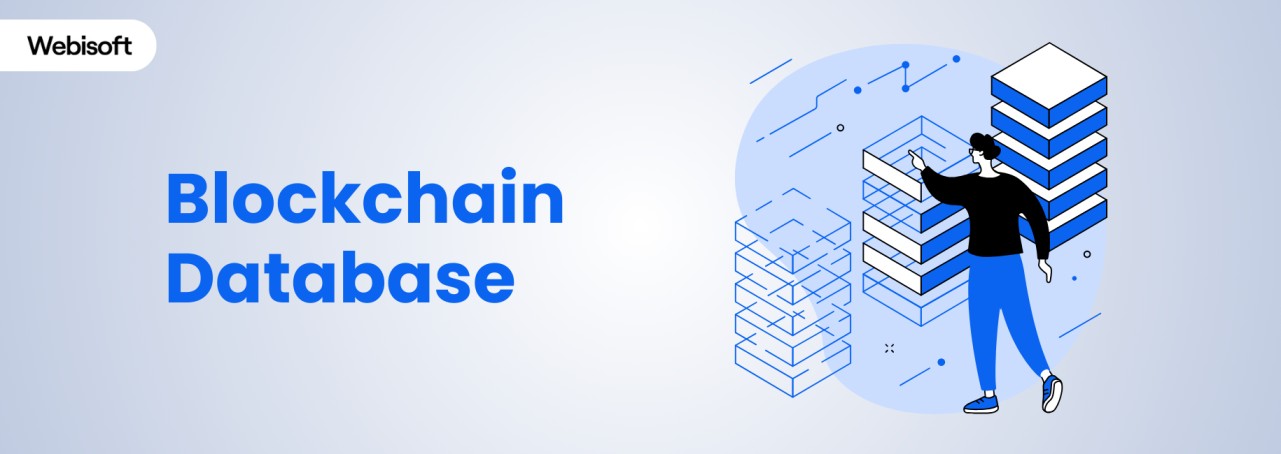Did you know that blockchain databases combine the features of modern databases with the security of blockchains? This powerful fusion ensures data security and integrity, addressing past concerns and creating a way for a new era in data management.
So, what exactly are blockchain databases?
In the simplest terms, they are secure digital ledgers that record transactions across a network of computers. Unlike traditional databases, they are decentralized, meaning no single entity controls them.
In this comprehensive blog, we’ll learn more about blockchain database. Also, we’ll explore their various types, highlight their benefits, and provide a step-by-step guide on creating your very own blockchain database.
So, let’s begin!
Contents
- 1 What is a Blockchain Database?
- 2 Blockchain Database VS Traditional Database
- 3 Types of Blockchain Databases
- 4 Benefits of Blockchain Databases
- 5 How to Create a Blockchain Database
- 5.1 Define Your Purpose
- 5.2 Select the Right Platform
- 5.3 Design Your Data Structure
- 5.4 Choose a Consensus Mechanism
- 5.5 Develop Smart Contracts (If Needed)
- 5.6 Set Up Nodes and Network
- 5.7 Testing Phase
- 5.8 Launch and Deployment
- 5.9 Ongoing Monitoring and Maintenance
- 5.10 Governance and Updates
- 5.11 Community Engagement (If Applicable)
- 5.12 Compliance and Regulations
- 6 Real-Life Applications of Blockchain Databases
- 7 Get the Best Blockchain Database Solutions
- 8 Conclusion
- 9 FAQs
What is a Blockchain Database?
A blockchain database is a decentralized and distributed digital ledger that records transactions across multiple computers. It consists of a chain of data blocks, with each block containing a set of transactions.
The key characteristic of a blockchain database is its immutability, meaning once data is recorded, it cannot be altered or deleted.
It relies on a network of nodes (computers) that validate and reach consensus on the data’s accuracy, ensuring transparency and security. Blockchain databases are often associated with cryptocurrencies like Bitcoin.
However, they have a wide range of applications beyond digital currencies, including supply chain management, healthcare, and more.
Blockchain Database VS Traditional Database
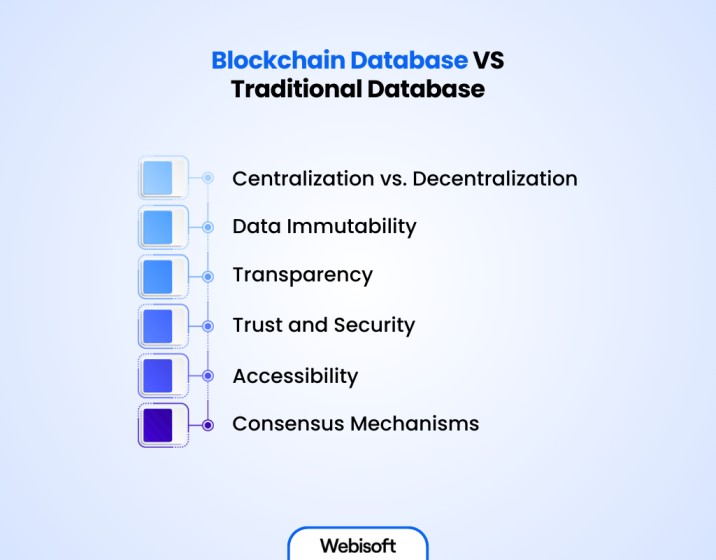
When we compare blockchain and traditional databases, we notice some significant differences. Some of them are:
| Aspect | Blockchain Database | Traditional Database |
| Control | Decentralized user control | Centralized authority control |
| Immutability | Highly resistant to changes/deletions | Alterable by authorized users |
| Transparency | High transparency, open access | Limited transparency, restrictions |
| Trust Mechanism | Trust via cryptography, consensus | Relies on authentication, intermediaries |
| Security | Strong due to cryptography, decentralization | Linked to central authority, potential vulnerabilities |
| Accessibility | Global via decentralized network | Restricted by setup |
| Consensus | Strong consensus (e.g., PoW, PoS) | Simpler validation methods |
| Scalability | Potential scaling issues | Customizable, may need more resources |
| Cost Efficiency | Cost-effective, fewer intermediaries | Costs vary, especially with security |
Centralization vs. Decentralization
Traditional databases are centralized, which means they’re controlled by a single entity or organization. This setup makes them vulnerable to failures or security breaches in that central authority.
In contrast, blockchain databases work on a decentralized network, spreading data across many computers. This reduces the risk because it’s like securing valuables in multiple vaults, making it much harder for a single point to compromise the entire system.
Data Immutability
Blockchain databases are known for data immutability. Once data is on the blockchain, it’s practically impossible to change or delete. Every block in the chain connects to the previous one, so altering one block would require changing all subsequent ones. This provides strong data integrity.
On the other hand, traditional databases allow authorized changes, which can raise concerns about data integrity and tampering.
Transparency
Blockchain databases provide a high level of transparency. Everyone in the network can see the complete transaction history, ensuring trust and accountability.
In contrast, traditional databases often restrict access to certain data, making it harder to build trust.
Trust and Security
Blockchain databases build trust using cryptography and consensus mechanisms, removing the need for intermediaries. Traditional databases rely on authentication and often require intermediaries, introducing potential security risks.
Accessibility
Blockchain databases offer global accessibility because they’re decentralized. Traditional databases might have limitations, especially in private networks or restricted access scenarios.
Consensus Mechanisms
Blockchain databases use strong consensus mechanisms like Proof of Work (PoW) or Proof of Stake (PoS) to ensure the accuracy and security of transactions. Traditional databases use simpler validation methods, which might not offer the same level of trust and security.
Types of Blockchain Databases
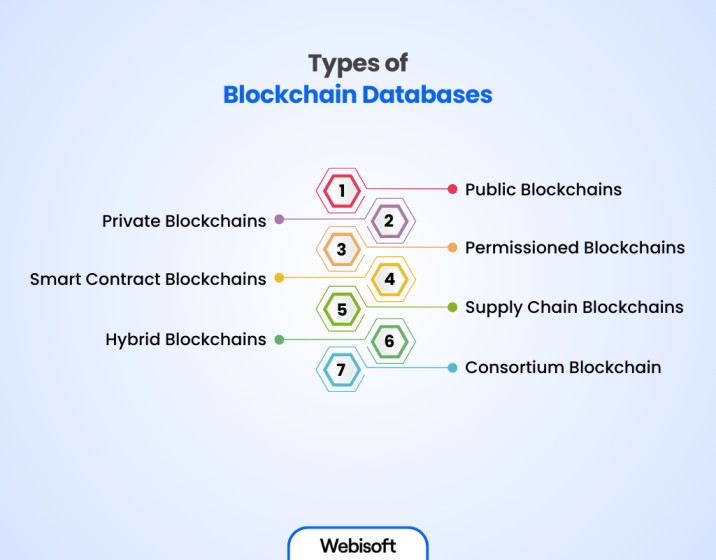
Blockchain databases come in different varieties, each designed for specific purposes. Let’s take a closer look at some of these types:
1. Public Blockchains
Public blockchains are openly accessible to anyone. They are highly transparent and not controlled by a single entity. Examples include Bitcoin and Ethereum.
These blockchains are suitable for various applications, particularly cryptocurrencies and decentralized applications (DApps).
2. Private Blockchains
Private blockchains are restricted to specific groups or organizations, ensuring controlled access. Hyperledger Fabric and Corda serve as examples of such networks.
These blockchains prioritize privacy and control, making them well-suited for enterprise use cases, supply chain management, and financial institutions.
3. Permissioned Blockchains
Permissioned blockchains require authorization for participation and transaction validation. They provide a higher level of control and security, making them suitable for business consortia and organizations with specific governance requirements.
4. Smart Contract Blockchains
Smart contract blockchains support programmable scripts that automate contract execution. Examples include Ethereum and Binance Smart Chain.
They enable decentralized applications (DApps), facilitating complex transactions and decentralized finance (DeFi).
5. Supply Chain Blockchains
Supply chain blockchains are designed to track and verify product movements and authenticity. They enhance transparency and traceability in supply chain management, reducing fraud and ensuring product integrity.
6. Hybrid Blockchains
Hybrid blockchains combine elements of both public and private blockchains, offering flexibility. They allow for transparency in specific transactions while ensuring privacy in others. This versatility makes them suitable for various applications, particularly those requiring a balance between openness and control.
7. Consortium Blockchain
Consortium blockchains are governed by a group of organizations or entities that share control. They promote collaboration and trust among consortium members. This makes them ideal for projects where multiple trusted parties need to work together in a shared and controlled environment.
Benefits of Blockchain Databases
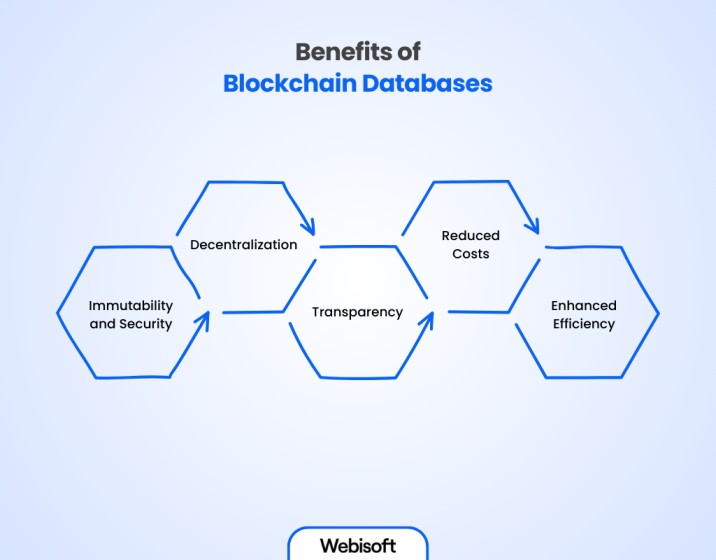
Blockchain databases offer numerous benefits. Let’s explore these benefits in more detail:
Immutability and Security
Blockchain’s immutable nature means that once data is recorded, it’s practically impossible to tamper with or alter. This security feature provides strong protection against fraud and unauthorized access.
Decentralization
Blockchain databases operate on a decentralized network, eliminating the need for central authorities or intermediaries. This decentralization minimizes the risk of corruption and manipulation, enabling trust and collaboration among users.
Transparency
Transparency is a cornerstone of blockchain technology. Every participant in the blockchain network can access the complete transaction history, from the very first entry to the latest one. This transparency serves as a crucial tool for accountability and trust-building.
Reduced Costs
Blockchain databases can significantly reduce transaction and administrative costs. This cost reduction is achieved by eliminating intermediaries and streamlining processes. When you remove the middlemen, transactions become more efficient and cost-effective.
Enhanced Efficiency
Blockchain’s automation capabilities and smart contracts are transformative for efficiency. Smart contracts are self-executing agreements with predefined terms written into code. They automate various processes, reducing the time required for tasks and operations.
How to Create a Blockchain Database
Creating a blockchain database is a systematic process that demands careful consideration and planning to ensure the success of your project. Here’s a step-by-step guide:
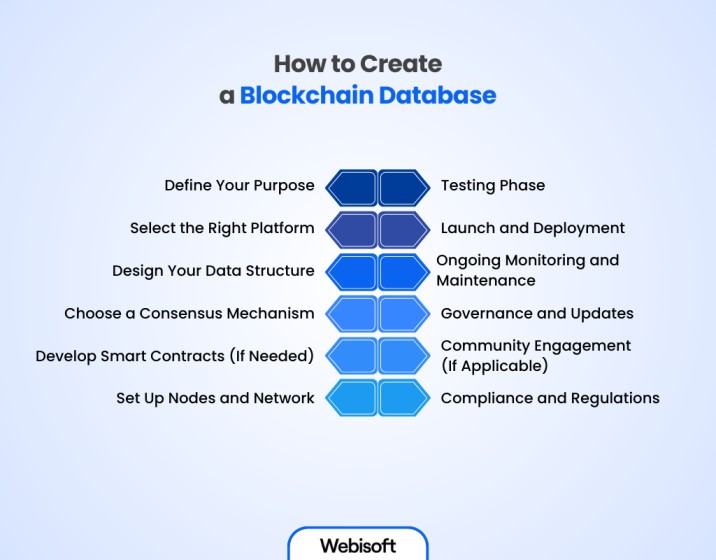
Define Your Purpose
Begin by clearly stating the specific purpose behind the creation of your blockchain database. The first and most crucial step is understanding the problem or process you want to improve, as this understanding will be the foundation that guides your project smoothly.
Select the Right Platform
The next logical step is to choose the appropriate blockchain platform for your project. Options like Ethereum, Hyperledger Fabric, and Binance Smart Chain offer various features and capabilities, so your choice should align with your project’s overarching goals to ensure a coherent outcome.
Design Your Data Structure
Once your platform is set up, concentrate on designing the structure of your data within the blockchain.
You should think about whether your project involves straightforward transactions or more complex data types. Developing a coherent data structure that includes data attributes is crucial to ensure consistency across your database.
Choose a Consensus Mechanism
The next step is choosing a consensus mechanism. Select the one that fits your project’s requirements the best, whether it’s Proof of Work (PoW), Proof of Stake (PoS), or another method. It’s important to make this choice carefully because it directly affects your database’s security and scalability.
Develop Smart Contracts (If Needed)
If your project involves automated processes or contracts, you should proceed with the development of smart contracts. These self-executing agreements provide a reliable way to ensure that your project’s objectives are consistently met.
Set Up Nodes and Network
The logical next step is constructing the network infrastructure by setting up nodes. These nodes serve as the backbone of your blockchain, validating transactions and ensuring its integrity.
Be sure to establish a coherent configuration of access controls and permissions to maintain security.
Testing Phase
Before launching, enter the testing phase to evaluate your blockchain for security vulnerabilities, scalability, and compatibility with your intended use cases. Consistency in this testing process is vital to identify and address any issues effectively.
Launch and Deployment
After successfully testing your blockchain network, you should move to the launch and deployment phase.
Deploy your blockchain network on the chosen platform to make it accessible to the intended users or participants. A well-planned deployment process will ensure a smooth transition to the operational phase.
Ongoing Monitoring and Maintenance
To maintain consistency in your project’s lifecycle, it is important to engage in continuous monitoring and maintenance. This involves regularly evaluating the blockchain’s performance and security to ensure it runs smoothly and securely.
Governance and Updates
Make clear rules in place for how your blockchain network will be managed. These rules should specify how decisions regarding updates and changes will be handled.
Regular updates are important as they are part of a well-thought-out strategy to improve the functionality and security of the network as time goes on.
Community Engagement (If Applicable)
When your blockchain involves a community of users or developers, encourage active engagement and collaboration. This approach to community involvement can result in valuable insights and sustainable growth.
Compliance and Regulations
Lastly, make sure your blockchain complies with the necessary legal and regulatory requirements. This is especially important if your blockchain deals with financial transactions or sensitive data.
Real-Life Applications of Blockchain Databases
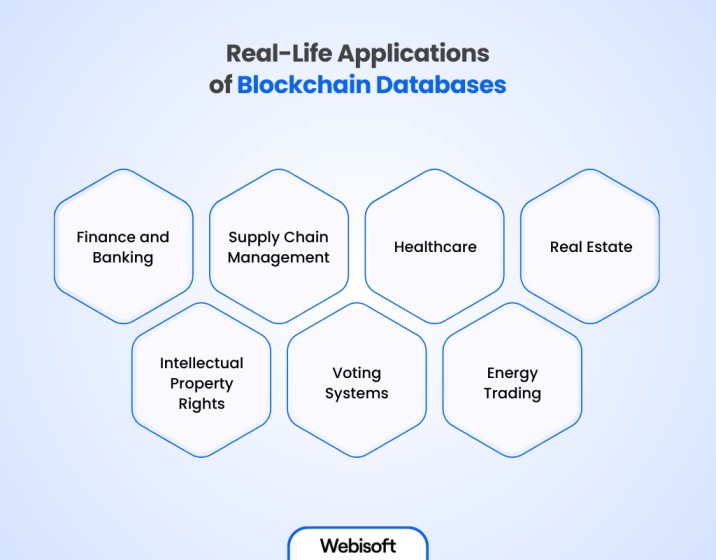
Blockchain databases have made a significant impact in various industries. Let’s explore some real-life applications:
Finance and Banking
In finance, blockchain databases have become a game-changer. They make cross-border transactions much faster and incredibly secure, which not only lowers expenses but also eliminates the need for multiple intermediaries.
Moreover, blockchain-based cryptocurrencies like Bitcoin and Ethereum have emerged as alternative investment options, expanding the financial industry.
Supply Chain Management
Blockchain databases are changing supply chain management. They offer transparency by allowing stakeholders to track products from their origin to the consumer. This reduces fraud and ensures the authenticity of products.
For example, consumers can verify the origin and journey of items like organic produce or luxury goods. This creates trust and reduces the circulation of counterfeit products.
Healthcare
The healthcare industry benefits from blockchain databases by improving data security and making medical record management simpler. Since patient data is highly confidential, it is protected with the highest level of security. This not only ensures patient privacy but also makes it easier for authorized parties to securely share medical information.
Real Estate
Blockchain is advancing in the real estate industry, where property transactions typically require multiple parties and complicated paperwork. However, blockchain simplifies this process by offering an unchangeable ledger of property ownership and transaction history, ensuring its integrity.
Intellectual Property Rights
In the entertainment and technology sectors, it’s important to protect intellectual property. Blockchain databases create a reliable and unchangeable record of these rights.
This means artists, musicians, writers, and inventors can rely on blockchain to prove ownership and prevent their creations from being used without permission.
Voting Systems
Blockchains are being considered for use in voting systems. This technology provides a reliable way to improve the honesty of elections by ensuring transparency and security throughout the voting process.
Each vote can be recorded and confirmed on the blockchain, decreasing the chances of fraud and manipulation.
Energy Trading
Blockchain technology is used in energy trading, allowing consumers to directly buy and sell surplus energy to others. It supports sustainability and reduces dependence on conventional energy suppliers.
Get the Best Blockchain Database Solutions
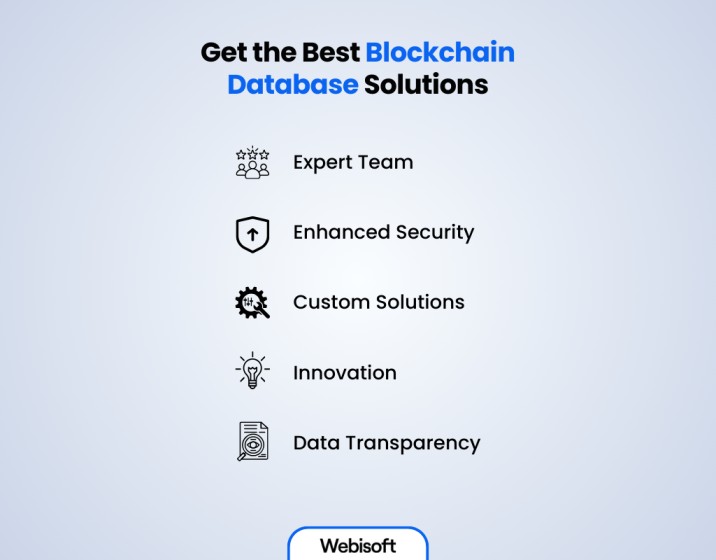
Webisoft is a leading provider of blockchain database solutions. We offer secure and efficient data management to enable business growth and innovation.
Let’s explore why you should choose Webisoft to get the best blockchain database solutions :
Expert Team
Webisoft’s team specializes in blockchain database solutions. With proven expertise, we develop systems that are secure, efficient, and customized to improve your data storage and management.
Enhanced Security
Our blockchain database solutions prioritize the utmost security. We employ advanced encryption and decentralization to protect your data against breaches and unauthorized access. This ensures your information remains safe and trustworthy.
Custom Solutions
Understanding the diversity in database needs, Webisoft offers customized blockchain solutions. We design databases that perfectly fit your organizational requirements, optimizing data flow and accessibility.
Innovation
Using the latest in blockchain technology, Webisoft’s innovative database solutions push the boundaries of data management. We offer features like real-time data synchronization and immutable transaction logs for improved reliability.
Data Transparency
Our solutions guarantee transparency in data handling. We provide an auditable and verifiable record of all transactions within your database. This enables trust and simplifies compliance.
Conclusion
To sum up, we’ve thoroughly explored blockchain databases, covering their advantages, different types, real-world applications, and even the process of creating one.
As we look ahead, the significance of blockchain databases in our data-centric era cannot be overstated. These secure and transparent data management solutions are set to play a vital role. They lay the foundation for a future where data integrity, security, and accessibility are crucial.
Now, it’s time for you to take the next step. If you’re inspired by the potential of blockchain databases and eager to utilize their capabilities for your business or project, Webisoft is here to guide you. Our experts are ready to help you explore the possibilities and implement blockchain database solutions customized to your needs.
FAQs
Can blockchain databases be hacked?
While blockchain databases are highly secure due to their decentralized nature, no system is entirely immune to attacks. However, the level of security in blockchain significantly reduces the risk of hacking.
Are blockchain databases energy-efficient?
Blockchain networks like Bitcoin can be energy-intensive, but newer blockchain technologies are exploring more energy-efficient consensus mechanisms.
Is it possible to delete data from a blockchain database?
Data on a blockchain is designed to be immutable, making it extremely difficult to delete. However, some newer blockchains allow for data pruning under certain conditions.
